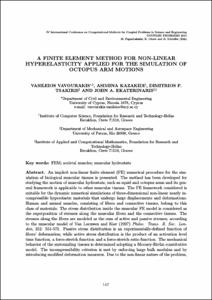Mostra el registre d'ítem simple
A finite element method for non-linear hyperelasticity applied for the simulation of octopus ARM motions
| dc.contributor.author | Vavourakis, Vasileios |
| dc.contributor.author | Kazakidi, Asimina |
| dc.contributor.author | Tsakiris, Dimitrios P. |
| dc.contributor.author | Ekaterinaris, John A. |
| dc.date.accessioned | 2020-07-16T09:32:57Z |
| dc.date.available | 2020-07-16T09:32:57Z |
| dc.date.issued | 2011 |
| dc.identifier.isbn | 978-84-89925-78-6 |
| dc.identifier.uri | http://hdl.handle.net/2117/193018 |
| dc.description.abstract | An implicit non-linear finite element (FE) numerical procedure for the simulation of biological muscular tissues is presented. The method has been developed for studying the motion of muscular hydrostats, such as squid and octopus arms and its general framework is applicable to other muscular tissues. The FE framework considered is suitable for the dynamic numerical simulations of three-dimensional non-linear nearly incompressible hyperelastic materials that undergo large displacements and deformations. Human and animal muscles, consisting of fibers and connective tissues, belong to this class of materials. The stress distribution inside the muscular FE model is considered as the superposition of stresses along the muscular fibers and the connective tissues. The stresses along the fibers are modeled as the sum of active and passive stresses, according to the muscular model of Van Leeuwen and Kier (1997) Philos. Trans. R. Soc. London, 352: 551-571. Passive stress distribution is an experimentally-defined function of fibers’ deformation; while active stress distribution is the product of an activation level time function, a force-stretch function and a force-stretch ratio function. The mechanical behavior of the surrounding tissues is determined adopting a Mooney-Rivlin constitutive model. The incompressibility criterion is met by enforcing large bulk modulus and by introducing modified deformation measures. Due to the non-linear nature of the problem, approximate determination of the Jacobian matrix is performed, in order to utilize the full Newton-Raphson iterative procedure within each time-step. In addition, time discretization is performed via the implicit Newmark method. We developed an open-source finite element code that is capable of simulating large deflection maneuvers of muscular hydrostats. The proposed methodology is validated by comparing the numerical results with existing measurements for the squid arm extension. The efficiency and robustness of the proposed numerical method is demonstrated through a series of octopus arm maneuvers, such as extension, compression and bending. |
| dc.format.extent | 13 p. |
| dc.language.iso | eng |
| dc.publisher | CIMNE |
| dc.subject | Àrees temàtiques de la UPC::Matemàtiques i estadística::Anàlisi numèrica::Mètodes en elements finits |
| dc.subject.lcsh | Finite element method |
| dc.subject.lcsh | Coupled problems (Complex systems) -- Numerical solutions |
| dc.subject.other | FEM; sceletal muscles; muscular hydrostats |
| dc.title | A finite element method for non-linear hyperelasticity applied for the simulation of octopus ARM motions |
| dc.type | Conference report |
| dc.subject.lemac | Elements finits, Mètode dels |
| dc.rights.access | Open Access |
| local.citation.contributor | COUPLED IV |
| local.citation.publicationName | COUPLED IV : proceedings of the IV International Conference on Computational Methods for Coupled Problems in Science and Engineering |
| local.citation.startingPage | 147 |
| local.citation.endingPage | 159 |


